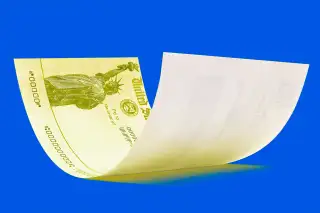Here's When Your Stimulus Check Should Arrive

Where's your coronavirus money? Early on, officials said that the first round of $1,200 stimulus checks were on track to be paid just after Easter, starting the week of April 13. Sure enough, many taxpayers received their coronavirus stimulus checks via direct deposit on Wednesday, April 15, and a small portion of people saw the payments arrive in their bank accounts even earlier.
That's right: Somewhat ironically, the IRS sent direct deposit stimulus checks at basically the exact same time it normally expects people to file their taxes. (Tax Day is usually April 15, but the 2020 filing deadline has been moved to July 15 according to the $2 trillion coronavirus stimulus package.)
Yet while the first stimulus payments were sent to taxpayers in mid-April, and most others should get payment by Memorial Day, it could take a lot longer for your check to arrive — assuming you meet the eligibility requirements.
As of Monday, March 30, the IRS said that "economic stimulus payments" worth up to $1,200 per adult would start being distributed "within the next three weeks." A few days later, on Thursday, April 2, Treasury Secretary Steven Mnuchin — who oversees the IRS — said at a press conference that the timeline was shifting and the first stimulus payments would arrive in some if not most taxpayers' accounts via direct deposit "within two weeks."
What's unclear, however, is when the last stimulus checks will be sent to taxpayers. Federal officials insist that the vast majority of stimulus check recipients will get their payments by early May if not the middle of April. But people who have not given their bank direct deposit information to the IRS and therefore must receive paper checks could see significant delays. Their stimulus checks might not arrive until later this spring, or even toward the tail end of summer.
How to Get a Stimulus Check Faster
To get your stimulus check as soon as possible, make sure you do two things:
• File your taxes for the 2018 or 2019 tax year, if you haven't already.
• Provide the IRS with your direct deposit information.
Your tax return includes your adjusted gross income and the ages of any dependents you claim. That's all the information the IRS needs to determine if you're eligible for a stimulus check, and how much money you get. (It's a maximum of $1,200 per adult, and $500 for every dependent 16 and under.)
The first coronavirus stimulus payments will be made directly to the bank accounts of taxpayers whose information is already on file with the IRS from the last time they did their taxes. That's why you should make sure the IRS has your bank direct deposit details; if you haven't given this information to the IRS, it could take a lot longer to get your stimulus check.
How to Give Direct Deposit Info to the IRS
It's been widely reported that it could take upwards of 20 weeks for all of the paper check stimulus payments to be sent by the IRS. That would mean that some people wouldn't get their checks until August or September.
The IRS says that most people owed stimulus payments — including those receiving paper checks — will get their money long before then. The House Ways & Means Committee dated April 2 said that the first paper check stimulus checks would be issued roughly three weeks after the first direct deposit payments, likely meaning the week of May 4. But a second House Ways & Means memo from April 16 indicated the first round of paper checks would go out the week of April 20. The Washington Post reported that the first paper check stimulus payments would go to people in the lowest-income bracket ($10,000 or less) starting April 24, and that more paper checks would be sent to higher-income individuals in subsequent weeks.
These people would theoretically get their payments quicker if the IRS could send the money electronically, straight to the taxpayer's bank account. At the end of March the IRS said in the coming weeks it "plans to develop a web-based portal for individuals to provide their banking information to the IRS online, so that individuals can receive payments immediately as opposed to checks in the mail."
On Friday, April 10, this IRS direct deposit portal went live, giving a spot for people who don't file taxes to provide their direct deposit information and other personal deals so they qualify for a speedy payment. Among the information asked for by the IRS are the dates of birth and Social Security numbers for each eligible person.
Later, the IRS launched the Get My Payment app, where taxpayers can add their direct deposit information in order to speed their stimulus payments along, or to track their check and find out when they would get their payment. However, in some cases, people attempting to use Get My Payment have been greeted with a frustrating "Payment Status Not Available" message.
Here are some of the reasons you might not have received your $1,200 check or can't get a payment status update.
Promoted:
Looking for money tips? Read:
5 Productive Things You Can Do While In Quarantine
Making Over $65K Per Year? Here Are 10 Smart Money Moves You Can Make Now